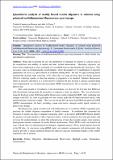| dc.contributor.author | Casamayou-Boucau, Yannick | |
| dc.contributor.author | Ryder, Alan G. | |
| dc.date.accessioned | 2021-02-02T09:28:28Z | |
| dc.date.available | 2021-02-02T09:28:28Z | |
| dc.date.issued | 2020-09-08 | |
| dc.identifier.citation | Casamayou-Boucau, Yannick, & Ryder, Alan G. (2020). Quantitative analysis of weakly bound insulin oligomers in solution using polarized multidimensional fluorescence spectroscopy. Analytica Chimica Acta, 1138, 18-29. doi:https://doi.org/10.1016/j.aca.2020.09.007 | en_IE |
| dc.identifier.issn | 1873-4324 | |
| dc.identifier.uri | http://hdl.handle.net/10379/16523 | |
| dc.description.abstract | Being able to measure the size and distribution of oligomers in solution is a critical issue in the manufacture and stability of insulin and other protein formulations. Measuring oligomers reliably can however be complicated, due to their fragile self-assembled structures, which are held together by weak forces. This can cause issues in chromatographic based methods, where dissociation or re-equilibration of oligomer populations can occur e.g. upon dilution in a different eluting buffer, but also for light scattering based methods like dynamic light scattering (DLS) where the size difference involved (often less than a factor 3) does not allow mixtures of oligomers to be resolved. Intrinsic fluorescence offers an attractive alternative as it is non-invasive, sensitive but also because it contains scattered light when implemented via excitation emission matrix (EEM) measurements, that is sensitive to changes in particle size. Here, using insulin at formulation level concentrations, we show for the first time how EEM can both discriminate and quantify the proportion of oligomeric states in solution. This was achieved by using the Rayleigh scatter (RS) band and the fluorescence signal contained in EEM. After validating size changes with DLS, we show in particular how the volume under the RS band correlated linearly with protein/oligomer molecular weight, in agreement with the Debye-Zimm relationship. This was true for the RS data from both EEM and polarized EEM (pEEM) measurements, the latter providing a stronger scatter signal, more sensitive to particle size changes. The fluorescence signal was then used with multivariate curve resolution (MCR) to quantify more precisely the soluble oligomer composition of insulin solutions. In conditions that promoted the formation of mainly one type of oligomer (monomer, dimer, or hexamer), pEEM-MCR helped identify the presence of small amounts of other oligomeric forms, while in conditions that were previously said to favour the insulin tetramer, we show that in the presence of zinc, these insulin samples were instead a heterogenous mixture composed of mostly dimers and hexamers. These MCR results correlated in all cases with the observed discrimination by principal component analysis (PCA), and deviations observed in the RS data. In conclusion, using pEEM scatter and emission components with chemometric data analysis provides a unique analytical method for characterising and monitoring changes in the soluble oligomeric state of proteins. | en_IE |
| dc.description.sponsorship | YCB was supported by an ‘EMBARK Initiative’ Postgraduate Scholarship (Grant number GOIPG/2015/3826) from the Irish Research Council. | en_IE |
| dc.format | application/pdf | en_IE |
| dc.language.iso | en | en_IE |
| dc.publisher | Elsevier | en_IE |
| dc.relation.ispartof | Analytica Chimica Acta | en |
| dc.rights | Attribution-NonCommercial-NoDerivs 3.0 Ireland | |
| dc.rights.uri | https://creativecommons.org/licenses/by-nc-nd/3.0/ie/ | |
| dc.subject | Protein | en_IE |
| dc.subject | Oligomers | en_IE |
| dc.subject | Multidimensional fluorescence | en_IE |
| dc.subject | Rayleigh scatter | en_IE |
| dc.subject | Polarization | en_IE |
| dc.subject | Chemometrics | en_IE |
| dc.title | Quantitative analysis of weakly bound insulin oligomers in solution using polarized multidimensional fluorescence spectroscopy | en_IE |
| dc.type | Article | en_IE |
| dc.date.updated | 2021-02-01T11:35:02Z | |
| dc.identifier.doi | 10.1016/j.aca.2020.09.007 | |
| dc.local.publishedsource | https://doi.org/10.1016/j.aca.2020.09.007 | en_IE |
| dc.description.peer-reviewed | peer-reviewed | |
| dc.contributor.funder | Irish Research Council | en_IE |
| dc.internal.rssid | 23541024 | |
| dc.local.contact | Alan Ryder, School Of Chemistry, Room 213, Arts/Science Building, South Cam, Nui Galway. 2943 Email: alan.ryder@nuigalway.ie | |
| dc.local.copyrightchecked | Yes | |
| dc.local.version | ACCEPTED | |
| nui.item.downloads | 134 | |


